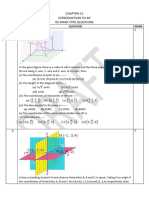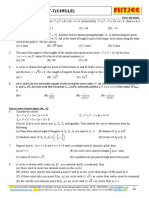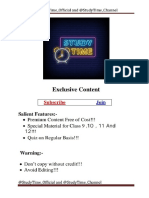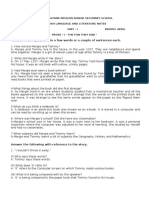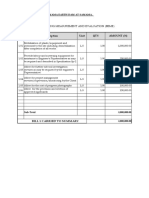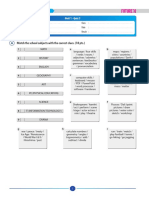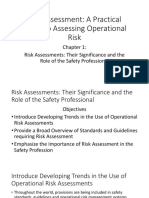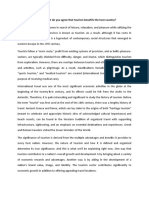Co-Ordinate Geometry: Points To Remember
Co-Ordinate Geometry: Points To Remember
Uploaded by
Sipra PaulCopyright:
Available Formats
Co-Ordinate Geometry: Points To Remember
Co-Ordinate Geometry: Points To Remember
Uploaded by
Sipra PaulOriginal Title
Copyright
Available Formats
Share this document
Did you find this document useful?
Is this content inappropriate?
Copyright:
Available Formats
Co-Ordinate Geometry: Points To Remember
Co-Ordinate Geometry: Points To Remember
Uploaded by
Sipra PaulCopyright:
Available Formats
www.puucho.
com
CHAPTER 3
CO-ORDINATE GEOMETRY
Points to Remember :
1. Coordinate axes : Two mutually perpendicular lines X´OX and YOY´ known as x-axis and y-axis
respectively, constitutes to form a co-ordinate axes system. These axes interests at point O, known as
origin.
2. Co-ordinate axes divides the plane into four regions, known as Quadrants.
3. The position of any point in a plane is determined with reference to x-axis and y-axis.
4. The x-coordinate of a point is its perpendicular distance from the y-axis measured along the x-axis. The
x-coordinate is known as abscissa.
5. The y-coordinate of a point is its perpendicular distnace from the x-axis measured along the y-axis. The
y-coordinate is known as ordinate.
6. Abscissa and ordinate of a point written in the form of ordered pair, (ascissa, ordinate) is known as the
co-ordinate of a point.
7. If the point in the plane is given, we can find the ordered pair of its co-ordinate and if the ordered pair of
real numbers is given, we can find the point in the plane corresponding to this ordered pair.
Quadrant
I II III IV
Sign of
8. Sing Convention :
x coordinate – –
y coordinate – –
26 CO-ORDINATE GEOMETRY MATHEMATICS–IX
www.puucho.com
ILLUSTRATIVE EXAMPLES
Example 1. Write the answer of each of the following questions:
(i) What is the name of the horizontal and the vertical lines drawn to determine the position of
any point in the cartesian plane?
(ii) What is the name of each part of the plane formed by these two lines?
(iii) Write the name of the point where these two lines intersect? —NCERT
Solution. (i) Rectangular axes/co-ordinate axes
(ii) Quadrant
(iii) Origin
Example 2. Write the co-ordinate of points A, B, C, D, E and F.
Solution. Here, the co-ordinate of A are (3, 3) ; of B are (6, 0) ; of C are (–3, 2) ; of D are (5, –4) ; of E are
(0, –5) and of F are (–6, –2).
Example 3. In which quadrant, do the following points lies?
A (3, 7), B (–9, –6), C (10, 15) and D (–5, 9)
Solution. In A (3, –7), x co-ordinate is positive and y-coordinate is negative. A lies in IVth quadrant.
Similarly, B lies in IIIrd quadrant ; C lies in Ist quadrant and D lies in IInd quadrant.
Example 4. Plot the following points with given co-ordinates in a plane. A (4, 3), B (–5, 2), C (0, –5), D (5, 0), E
(–5, –3) and F (3, –4).
Solution. For plotting A (4, 3), we first move 4 units along OX and then 3 units along OY. Similary. other point
can be drawn.
MATHEMATICS–IX CO-ORDINATE GEOMETRY 27
www.puucho.com
A (4, 3)
Example 5. Look at the figure given, and write the following :
(i) The co-ordinate of A. (ii) The abscissa of point B.
(iii) The ordinate of point C. (iv) The co-ordinate of D.
(v) The point whose co-ordinate are (–2, 5).
Solution. (i) Co-ordinate of A are (6, –4) (ii) Abscissa of B is 2.
(iii) Ordinate of C is –3 (iv) Co-ordinates of D are (4, 3)
(v) Point E have co-ordinate as (–2, 5)
28 CO-ORDINATE GEOMETRY MATHEMATICS–IX
www.puucho.com
Example 6. Plot the points (x, y) given in the following table on the plane choosing suitable units of distance
on the axes.
x 2 1 0 1 3
y 8 7 1.25 3 1
—NCERT
Solution.
Example 7. Plot the points A (–3, –3), B (5,–3), C (5, 2) and D (–3, 2) on the graph paper. Join them in order and
name the figure so formed. Also, find its area.
Solution.
MATHEMATICS–IX CO-ORDINATE GEOMETRY 29
www.puucho.com
ABCD is a rectangle
Area of ABCD = AB × BC = 8 × 5 sq. units = 40 sq. units
Example 8. Graph the following equations
(i) x = –2 (ii) y = 3 (iii) y = x + 2
Solution. (i) x = –2. The given equation can be written as 1.x + 0.y = –2 x is fixed as –2 and y may choose
any value. Let us represent following information in a tabular form.
x 2 2 2 2 2
y 2 1 0 1 2
(ii) y = 3. Given equation may be written as 0.x + 1.y = 3 y is fixed as 3 and x may choose any
value. Let us represent this information in a tabular form.
x 2 1 0 1 2
y 3 3 3 3 3
(iii) y = x + 2
here, when x = 0, y = 2 ; x = 1, y = 3 ; x = –1, y = 1 etc. Represent this in the tabular form.
x 1 0 1 2
y 1 2 3 4
30 CO-ORDINATE GEOMETRY MATHEMATICS–IX
www.puucho.com
PRACTICE EXERCISE
1. State the quadrant in which the following points lie.
(i) A (3, –4) (ii) B (–5, 11) (iii) C (–10, –15) (iv) D (8, 12)
(v) E (–11, 5) (vi) F (–100, –200) (vii) G (10, 50) (viii) H (20, –5)
2. Look at the figure given, and write the following :
(i) The co-ordinate of P (ii) The ordinate of Q
(iii) The abscissa of R (iv) The point given by (4, –3)
(v) The point which is at a distance of 3 units from y-axis
(vi) Co-ordinate of point T
MATHEMATICS–IX CO-ORDINATE GEOMETRY 31
www.puucho.com
3. Plot the points P (1, 3), Q (3, 7) and R (5, 11). Are these points collinear?
4. Plot the points A (–2, 3), B (8, 3) and C (6, 7). Join them in order. Name the figure obtained. Also find its
area.
5. Plot the points A (3, 2), B (11, 8), C (8, 12) and D (0, 6). Join them in order. Name the figure thus obtained.
6. Plot the points P (0, –1), Q (2, 1), R (0, 3), S (–2, 1). Join them in order. Name the figure obtained.
7. Plot the points A (–2, 1), B (1, 1), C (–4, –3) and D (3, –3). Join them in order. Name the figure thus
obtained.
8. Plot the points P (7, 3), Q (3, 0), R (0, –4) and S (4, –1). Join them in order. Name the figure thus obtained.
9. Plot the points A (0, 3), B (–4, 1), C (0, –6) and D (4, 1). Join them in order. Name the figure thus obtained.
10. Graph the folloiwng equations :
(i) x = 4 (ii) y = –3 (iii) y = x (iv) x + y = 3
PRACTICE TEST
M.M : 15 Time : 1/2 hour
General Instructions :
All questions carry 3 marks each.
1. Name the quadrant in which the following points lie :
(i) A (–7, 9) (ii) B (–10, – 25) (iii) C (7, –9) (iv) D (11, 7)
2. Plot A (–6, 3), B (6, 0) and C (4, 5). Join these points in order. Name the figure thus obtained.
3. Look at the figure and write the following :
(i) The co-ordinate of A.
(ii) The co-ordinate of B.
(iii) The abscissa of C.
(iv) The point whose co-ordinates are (–4, 3)
Y
6 A
5
4
D
3
2
1
0 1 X
–7 –6 –5 –4 –3 –2 –1 2 3 4 5 6 7 8
–1
–2
–3
C
–4
–5 B
32 CO-ORDINATE GEOMETRY MATHEMATICS–IX
www.puucho.com
4. Mark the points P (–4, 2), Q (–4, –4), R (3, –4) and S (3, 2) on the graph paper. Join these points in order.
Name the figure obtained. Also, find area of the figure obtained.
5. Draw the graph of y = x + 1. Does the point (–7, 6) lie on this line?
ANSWERS OF PRACTICE EXERCISE
1. (i) IVth quadrant (ii) IInd qudrant (iii) IIIrd quadrant (iv) Ist quadrant
(v) IInd qudrant (vi) IIIrd quadrant (vii) Ist quadrant (viii) IVth qudrant
2. (i) P (–5, 4) (ii) Q (4, 2) (iii) –6 (iv) T
(v) S (vi) T (4, –3)
3. yes
4. Triangle, Area = 20 sq. units
MATHEMATICS–IX CO-ORDINATE GEOMETRY 33
www.puucho.com
5. Rectangle 6. Square
7. Trapezium 8. Rhombus
34 CO-ORDINATE GEOMETRY MATHEMATICS–IX
www.puucho.com
9. Kite
10.
(i) (ii)
MATHEMATICS–IX CO-ORDINATE GEOMETRY 35
www.puucho.com
(iii) (iv)
ANSWERS OF PRACTICE TEST
1. (i) IInd quadrant (ii) IIIrd qudrant (iii) IVth quadrant (iv) Ist quadrant
2. Triangle
3. (i) A (7, 6) (ii) B (2, –5) (iii) –4 (iv) D
4. Rectangle, Area = 42 square units
36 CO-ORDINATE GEOMETRY MATHEMATICS–IX
www.puucho.com
5. No
MATHEMATICS–IX CO-ORDINATE GEOMETRY 37
You might also like
- Advanced Cleaning Product Formulations VDocument255 pagesAdvanced Cleaning Product Formulations VPeter munodaz100% (1)
- Co-Ordinate Geometry-Practice WorksheetDocument2 pagesCo-Ordinate Geometry-Practice WorksheetANS FF GAMINGNo ratings yet
- NCERT Grade 09 Mathematics Coordinate-GeometryDocument5 pagesNCERT Grade 09 Mathematics Coordinate-GeometryKhushi sharmaNo ratings yet
- Ncert Sol For Class 9 Maths Chapter 3Document4 pagesNcert Sol For Class 9 Maths Chapter 3streakof happinesssNo ratings yet
- Coordinate Geometry - Elite - 1Document4 pagesCoordinate Geometry - Elite - 1aryanyt6996No ratings yet
- class-IXModel Question Paper Coordinate GeometryDocument5 pagesclass-IXModel Question Paper Coordinate GeometryiuuuujNo ratings yet
- Exercise 3.1: NCERT Solution For Class 9 Maths Chapter 3-Coordinate GeometryDocument4 pagesExercise 3.1: NCERT Solution For Class 9 Maths Chapter 3-Coordinate GeometryRajeshNo ratings yet
- AssignmentNo 5 (CoordinateGeometrySubjective)Document1 pageAssignmentNo 5 (CoordinateGeometrySubjective)raman21400No ratings yet
- Mathematics Worksheets 4Document7 pagesMathematics Worksheets 4MANU KALIA CNo ratings yet
- 03 Coordinate Geometry Subjective QuestionsDocument7 pages03 Coordinate Geometry Subjective Questionsshweta_angel90100% (1)
- Co - Ordinate Geometry WSHDocument5 pagesCo - Ordinate Geometry WSHMONICA JOYALNo ratings yet
- RS Aggarwal Solutions Class 9 Maths Chapter 5 Coordinate GeometryDocument5 pagesRS Aggarwal Solutions Class 9 Maths Chapter 5 Coordinate Geometryrim45621No ratings yet
- 2021-2022-Class IX-Mathematics-Part 1-AWDocument100 pages2021-2022-Class IX-Mathematics-Part 1-AWmerita369meNo ratings yet
- Microsoft Word - Std-ix Coordinate Geometry Worksheet.docxDocument4 pagesMicrosoft Word - Std-ix Coordinate Geometry Worksheet.docxSaraf santhosh kumarNo ratings yet
- Physics 12Document1 pagePhysics 12ks0961788No ratings yet
- XII Maths Unit Test - Chapter - 10 and 11 (Dr. Amit Bajaj)Document3 pagesXII Maths Unit Test - Chapter - 10 and 11 (Dr. Amit Bajaj)Rhythm MishraNo ratings yet
- 5 Mark Type Introduction To 3d 2Document9 pages5 Mark Type Introduction To 3d 2Sarvajith Venu bhai vlogNo ratings yet
- Maths Class Xi Introduction To 3 Dimensional Geometry Practice Paper 11Document3 pagesMaths Class Xi Introduction To 3 Dimensional Geometry Practice Paper 11Arjun KumarNo ratings yet
- QP CB IX Math CH 3 Coordinate GeometrymainDocument7 pagesQP CB IX Math CH 3 Coordinate Geometrymainmaurya.ghanshyam101984No ratings yet
- Concise Selina Solutions For Class 9 Maths Chapter 26 Co Ordinate Geometry PDFDocument53 pagesConcise Selina Solutions For Class 9 Maths Chapter 26 Co Ordinate Geometry PDFBINDHU BINUNo ratings yet
- 03-Co-Ordinate Geometry (Part-2)Document4 pages03-Co-Ordinate Geometry (Part-2)anilsisodia78No ratings yet
- GRAPHSDocument3 pagesGRAPHSBjajnNo ratings yet
- Class 10 Math CoordinentDocument2 pagesClass 10 Math CoordinentHarsh PandeyNo ratings yet
- 2023 2024 Class IX Mathematics Part 1 AW 2Document47 pages2023 2024 Class IX Mathematics Part 1 AW 2Aditya KaradkarNo ratings yet
- CBSE Class 9 Mathematics Worksheet - Coordinate GeometryDocument5 pagesCBSE Class 9 Mathematics Worksheet - Coordinate Geometrysaipranav chinthakuntaNo ratings yet
- Class Ix Mathematics Worksheet CH 3 "Coordinate Geometry"Document3 pagesClass Ix Mathematics Worksheet CH 3 "Coordinate Geometry"ANUJ KALRANo ratings yet
- Coordinate Geometry Exercises and SolutionsDocument28 pagesCoordinate Geometry Exercises and SolutionsSetiawan TanadiNo ratings yet
- MAT3100 Tut3Document2 pagesMAT3100 Tut3Kelvin BwalyaNo ratings yet
- Mtahs Class XIIDocument6 pagesMtahs Class XIIRahul pandeyNo ratings yet
- Coordinate Geometry WorksheetDocument4 pagesCoordinate Geometry Worksheetvarsha TamhaneNo ratings yet
- Coordinate Geometry Imp Questions Paper 1Document2 pagesCoordinate Geometry Imp Questions Paper 1sspanda19999No ratings yet
- Coordinate GeometryDocument4 pagesCoordinate GeometrypskavithaNo ratings yet
- Coordinate Geometry Class: Ix Subject: MathematicsDocument1 pageCoordinate Geometry Class: Ix Subject: Mathematicssaipranav chinthakuntaNo ratings yet
- Coordinate GeometryDocument87 pagesCoordinate GeometryDharmi GhevariyaNo ratings yet
- NAME: - CLASS: IX SEC:: - ROLL # - Topic: Co-Ordinate Geometry RGS/IX/20-21/MATHS/301Document2 pagesNAME: - CLASS: IX SEC:: - ROLL # - Topic: Co-Ordinate Geometry RGS/IX/20-21/MATHS/301Iyaadaddadad RayayaanaNo ratings yet
- NCERT Solutions For Class 9 Maths Chapter 3 Coordinate GeometryDocument6 pagesNCERT Solutions For Class 9 Maths Chapter 3 Coordinate GeometryzxcvbnmkhannaNo ratings yet
- Class X - Reflections - (24-25)Document17 pagesClass X - Reflections - (24-25)aruthakur29032009No ratings yet
- COORDINATE GEOMETRY NotesDocument2 pagesCOORDINATE GEOMETRY Noteslakshithasridhar2010No ratings yet
- 10th Quetion PaperDocument4 pages10th Quetion PaperSathya VeenaNo ratings yet
- Grade 10 Class Test3- Coordinate GeometryDocument2 pagesGrade 10 Class Test3- Coordinate Geometryeesha.thanmayiNo ratings yet
- Math 10 Diagnostic TestDocument3 pagesMath 10 Diagnostic TestBaisalam MandingNo ratings yet
- Coordinate Plane _ 3Document9 pagesCoordinate Plane _ 3Lan LanNo ratings yet
- Prelim Maths Part - 1Document5 pagesPrelim Maths Part - 1varadbhamare22No ratings yet
- Straight Lines WSDocument11 pagesStraight Lines WSManan SharmaNo ratings yet
- Coordinate geometry worksheetDocument2 pagesCoordinate geometry worksheetmancoder277No ratings yet
- Worksheet Class 9Document91 pagesWorksheet Class 9bulletinsocketNo ratings yet
- Coordinate Geometry Free PDF Class 9th PracticeDocument28 pagesCoordinate Geometry Free PDF Class 9th Practiceshubranshyajat2008No ratings yet
- 1688972312795.QP PS CBSE IX Math Co-Ordinate GeometryDocument5 pages1688972312795.QP PS CBSE IX Math Co-Ordinate Geometrypadmasree sagiNo ratings yet
- Atm SL1Document3 pagesAtm SL1avinkandarNo ratings yet
- RS Aggarwal Solutions For Class 9 Maths Chapter 5 Coordinate GeometryDocument5 pagesRS Aggarwal Solutions For Class 9 Maths Chapter 5 Coordinate GeometryscihimaNo ratings yet
- Co Ordinate GeometryDocument4 pagesCo Ordinate Geometrykumarm78No ratings yet
- 9 IHS Holiday HWDocument14 pages9 IHS Holiday HWdafuntastic4No ratings yet
- Maths Class Ix Chapter 03 Coordinate Geometry Practice Paper 03 2024Document4 pagesMaths Class Ix Chapter 03 Coordinate Geometry Practice Paper 03 2024Rishi GulimiNo ratings yet
- Class 9-Coordinate Geometry -Worksheet 1 (2024-25)Document3 pagesClass 9-Coordinate Geometry -Worksheet 1 (2024-25)rytd9wxwrzNo ratings yet
- 1. ( IX-CG-WS-01 ) (24-25) Coordinate GeometryDocument5 pages1. ( IX-CG-WS-01 ) (24-25) Coordinate Geometryrohanperso2010No ratings yet
- Answer The Following 12 X 1 12 MDocument4 pagesAnswer The Following 12 X 1 12 Mpillaveerraju2001No ratings yet
- Class 9 Maths Chapter 3Document5 pagesClass 9 Maths Chapter 3THIRUMALAINo ratings yet
- Assignment ch-3 Coordinate geometry pdf important MathsDocument8 pagesAssignment ch-3 Coordinate geometry pdf important Mathspr7903046033No ratings yet
- 5 - 6 - Intersection of Plane Ad Lines and AnglesDocument11 pages5 - 6 - Intersection of Plane Ad Lines and AnglesSudibyo GunawanNo ratings yet
- Geometry and Locus (Geometry) Mathematics Question BankFrom EverandGeometry and Locus (Geometry) Mathematics Question BankNo ratings yet
- Downloaded From: Study TimeDocument38 pagesDownloaded From: Study TimeSipra PaulNo ratings yet
- WT 7 (Circle)Document2 pagesWT 7 (Circle)Sipra PaulNo ratings yet
- Downloaded From: Study TimeDocument38 pagesDownloaded From: Study TimeSipra PaulNo ratings yet
- English Guide: 20.1 Shouldn't Miss School. Our Runaway KiteDocument1 pageEnglish Guide: 20.1 Shouldn't Miss School. Our Runaway KiteSipra PaulNo ratings yet
- Adobe Scan 01-Mar-2022Document1 pageAdobe Scan 01-Mar-2022Sipra PaulNo ratings yet
- IOQM 2022 23 Final AnswersDocument2 pagesIOQM 2022 23 Final AnswersSipra PaulNo ratings yet
- @StudyTime - Channel Maths-1 PDFDocument12 pages@StudyTime - Channel Maths-1 PDFSipra PaulNo ratings yet
- NTSEResult2019 PDFDocument1 pageNTSEResult2019 PDFSipra PaulNo ratings yet
- @StudyTime - Channel Maths-7 PDFDocument8 pages@StudyTime - Channel Maths-7 PDFSipra PaulNo ratings yet
- @StudyTime - Channel Maths-4Document12 pages@StudyTime - Channel Maths-4Sipra PaulNo ratings yet
- @StudyTime - Channel Maths-6Document10 pages@StudyTime - Channel Maths-6Sipra PaulNo ratings yet
- Downloaded From: Study TimeDocument42 pagesDownloaded From: Study TimeSipra PaulNo ratings yet
- @StudyTime - Channel Maths-4 PDFDocument12 pages@StudyTime - Channel Maths-4 PDFSipra PaulNo ratings yet
- @StudyTime - Channel 12 - Sound (Ex) PDFDocument10 pages@StudyTime - Channel 12 - Sound (Ex) PDFSipra PaulNo ratings yet
- @StudyTime - Channel Maths-4Document12 pages@StudyTime - Channel Maths-4Sipra PaulNo ratings yet
- 186online Class Schedule From 03-11-2020 To 08-11-2020 PDFDocument6 pages186online Class Schedule From 03-11-2020 To 08-11-2020 PDFSipra PaulNo ratings yet
- @StudyTime - Channel Maths-6Document10 pages@StudyTime - Channel Maths-6Sipra PaulNo ratings yet
- @StudyTime - Channel Maths-6 PDFDocument10 pages@StudyTime - Channel Maths-6 PDFSipra PaulNo ratings yet
- Surface Areas and Volumes: Points To RememberDocument28 pagesSurface Areas and Volumes: Points To RememberSipra PaulNo ratings yet
- @StudyTime - Channel Maths-13Document12 pages@StudyTime - Channel Maths-13Sipra PaulNo ratings yet
- Pag Odee: He Aoto NialDocument2 pagesPag Odee: He Aoto NialSipra PaulNo ratings yet
- VIII Class SolutionsDocument5 pagesVIII Class SolutionsSipra PaulNo ratings yet
- Polynomials: Points To RememberDocument12 pagesPolynomials: Points To RememberSipra PaulNo ratings yet
- An Effective Well Development Method For Deep Screen Completed WellsDocument6 pagesAn Effective Well Development Method For Deep Screen Completed WellsMonica UrbietaNo ratings yet
- 06.CS660-05 Technical Specifications S223.1263-02 en-USDocument34 pages06.CS660-05 Technical Specifications S223.1263-02 en-USWalter BarradasNo ratings yet
- Cesc M1Document24 pagesCesc M1Marc Byron Manguba100% (1)
- Answer These Questions in A Few Words or A Couple of Sentences EachDocument9 pagesAnswer These Questions in A Few Words or A Couple of Sentences EachShyamala SubramanianNo ratings yet
- Earth Dam Rehabilitation BEMEDocument6 pagesEarth Dam Rehabilitation BEMENuruddeen Muhammad100% (1)
- S0600 Aa Pro 130Document23 pagesS0600 Aa Pro 130opruzhak-boxNo ratings yet
- Quiz 10 Sinif Ingilizce 1 Unite School Life Degerlendirme Sinavi 2 Keep Up 73976Document3 pagesQuiz 10 Sinif Ingilizce 1 Unite School Life Degerlendirme Sinavi 2 Keep Up 73976EMRE FIÇICINo ratings yet
- The Resilience of Energy Supply Chains A Multiple Case Study Approach On Oil and Gas Supply Chains To EuropeDocument20 pagesThe Resilience of Energy Supply Chains A Multiple Case Study Approach On Oil and Gas Supply Chains To Europemuh.dahnilNo ratings yet
- Revised Cutoff Report M Tech M DesDocument5 pagesRevised Cutoff Report M Tech M Desaustin00012No ratings yet
- Valvoline Indrustrial GearDocument1 pageValvoline Indrustrial GearJUAN BAUTISTANo ratings yet
- SSLM RWS Q4 Week 3Document4 pagesSSLM RWS Q4 Week 3Raquel ArtisuelaNo ratings yet
- Risk Assessment - Chapter 1Document26 pagesRisk Assessment - Chapter 1Alexandre Hugen50% (2)
- Early Intervention and The Development o Self RegulationDocument31 pagesEarly Intervention and The Development o Self RegulationnicolasNo ratings yet
- StoicismDocument9 pagesStoicismAllan Azogue100% (1)
- LESSON PLAn of Squares and RectanglesDocument3 pagesLESSON PLAn of Squares and Rectangleskiran malikNo ratings yet
- Boq 877243Document12 pagesBoq 877243masumnetrokona26No ratings yet
- Tourism EassyDocument13 pagesTourism EassyHamza Farooq KoraiNo ratings yet
- Dr. Lars Ramskold PDFDocument2 pagesDr. Lars Ramskold PDFАртур ДегтярёвNo ratings yet
- Hydroxyl Compounds (Alcohols)Document7 pagesHydroxyl Compounds (Alcohols)Nazmul NayeemNo ratings yet
- Cosmic DebrisDocument4 pagesCosmic DebrisRODJHEN ANNE P. BARQUILLANo ratings yet
- Cause and Effect Reading and VocabDocument294 pagesCause and Effect Reading and VocabSeva SuleymanovaNo ratings yet
- Pranotherapy The Gift of HealingDocument2 pagesPranotherapy The Gift of HealingLuk Van Den BoschNo ratings yet
- General Education Curriculum Map July 2023 Rev 1Document6 pagesGeneral Education Curriculum Map July 2023 Rev 1suren.hakobyan.vardaniNo ratings yet
- LESSON 1 - Visualization and Identification of Numbers From 101-500Document21 pagesLESSON 1 - Visualization and Identification of Numbers From 101-500Kleng Delos Santos Bernardo100% (1)
- الاحتياجات التدريبيةDocument22 pagesالاحتياجات التدريبيةأسيل سعيد الحسناتNo ratings yet
- How To Have A Good DayDocument13 pagesHow To Have A Good DayNemuel KesslerNo ratings yet
- Mixed Tenses TestDocument6 pagesMixed Tenses TestDANIELA SIMONELLINo ratings yet
- JHS Science Recovery Plan A.Y. 2022-2024Document6 pagesJHS Science Recovery Plan A.Y. 2022-2024Aiza CabatinganNo ratings yet
- Customer Satisfaction SurveyDocument7 pagesCustomer Satisfaction SurveyKervie ManuelNo ratings yet
















